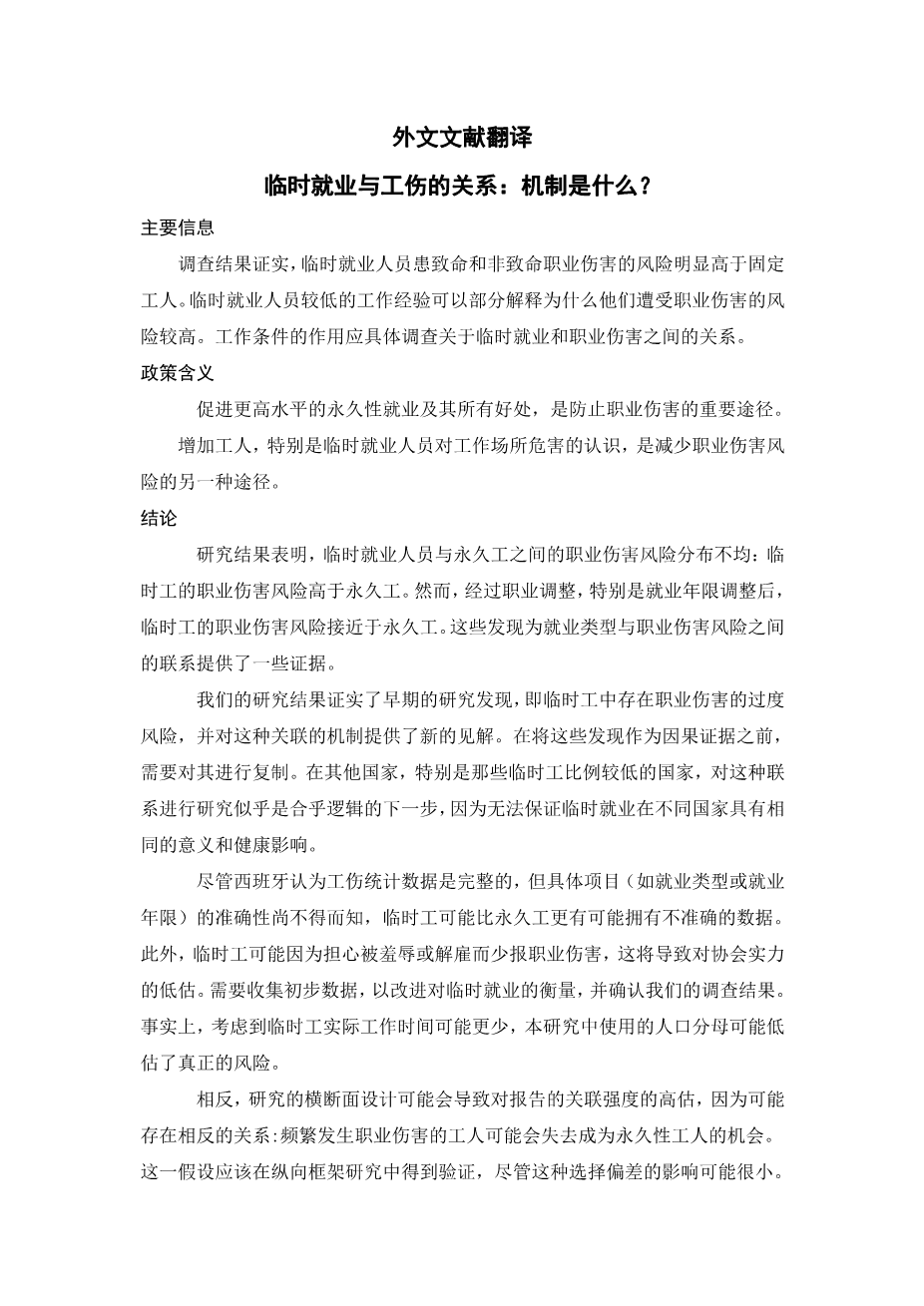外文文献阅读
Associations between temporary employment and occupational injury: what are the mechanisms?
Main messages
Findings confirm that temporary workers have a significantly higher risk of having fatal and non-fatal occupational injuries than permanent workers.
Lower job experience of temporary workers may partially explain why they are at a higher risk of experiencing occupational injuries.
The role of working conditions should be specifically investigated regarding the association between temporary employment and occupational injuries.
Policy Implications
Promoting a higher level of permanent employment, with all of its benefits, is an important way towards preventing occupational injuries.
Increasing workersrsquo; knowledge of workplace hazards, especially among temporary workers, is an additional way of reducing the risk of occupational injuries.
DISCUSSION
Results from this study show that the risk of occupational injury is unequally distributed between temporary and permanent employment: temporary workers have higher risk than permanent workers. However, after adjusting by occupation, and particularly length of employment, the risk of occupational injury among temporary workers approximates that of permanent workers. These findings provide some evidence about the link between type of employment and the risk of occupational injury.
Our results confirm earlier studies that found an excess risk of occupational injury among temporary workers,and provides new insight into the mechanism underlying the association. These findings need to be replicated before they are taken as causal evidence. The study of this association in other countries, especially those with a lower proportion of temporary workers, would seem to be a logical next step since there is no guarantee that temporary employment has the same meaning and health effect impact in different countries.
Despite occupational injury statistics being considered complete in Spain,the accuracy of specific items such as type of employment or length of employment is unknown, and it is possible that temporary workers might be more likely to have inaccurate data than permanent workers. Furthermore, temporary workers may be underreporting occupational injuries because of fears of being stigmatised or fired, which would lead to an underestimate of the strength of the association. Primary data collection is needed to improve the measurement of temporary employment and confirm our findings. Indeed, given that temporary workers are likely to have fewer work hours actually worked, the true risk may actually be understated by the population denominator used in this study.
Conversely, the cross sectional design of the study could lead to an overestimation of the strength of reported association, because an inverse relation could be possible: workers with a high frequency of occupational injuries could lose opportunities to become permanent in their jobs. This hypothesis should be tested in a longitudinal framework study, although it is likely that this selection bias influence would be small.
According to our hypothesis, the association between temporary employment and occupational injuries can be explained by two mechanisms. Firstly, temporary workers are exposed to more hazardous working conditions than perma- nent workers. As observed from the distribution of workers by occupation: 26.1% of temporary workers versus 12.2% of permanent workers had non-qualified and elementary occupations, and 16.3% versus 30%, respectively, had management, professional, or technical occupations. In fact, the Third European Survey on Working Conditions has shown that workers with nonpermanent contracts are more likely to have unfavourable working conditions such as repetitive movements, painful and tiring positions, discrimination, low time control, and/or less freedom to choose when to take personal leave. Spanish surveys on working conditions show a similar pattern, especially in relation to ergonomic and psychosocial risk factors.In conclusion,on the whole, temporary workers toil in occupations with more hazardous working conditions. However, within occupational groups, temporary workers show significantly higher risks than permanent workers in almost all occupations, especially for non-fatal injuries. An explanation for this remarkable finding could be that temporary workers have less experience and knowledge of the workplace than permanent workers. In fact, when the length of employment is taken into account the observed association disappears in each group (data not shown), except for skilled agricultural and fishery workers. An alternative explanation could be that there were only nine occupational categories, and within each category there are different types of jobs. This may have led to underadjustment of the role of occupationally linked working conditions in the study. However, the persistent effect of temporary work in relatively homogeneous strata of occupations suggests that the first explanation has substantial merit. The role of working conditions in the observed association should be further assessed with more detailed information on work organisation and workplace hazards.
An unexpected inverse association was observed between permanent services workers, and skilled agricultural and fishery workers and fatal occupational injuries. A plausible explanation could be that many temporary workers in these occupations are self-employed, and do not record suffering occupational injuries.
A second mechanism should be considered as a possible explanation for these findings: permanent workers are likely to have better knowledge and experience of the workplace, tools, and activities than temporary workers. The results show, on the one hand, a clear inverse trend between length of employment and occ
剩余内容已隐藏,支付完成后下载完整资料


英语译文共 3 页,剩余内容已隐藏,支付完成后下载完整资料
资料编号:[411712],资料为PDF文档或Word文档,PDF文档可免费转换为Word
以上是毕业论文外文翻译,课题毕业论文、任务书、文献综述、开题报告、程序设计、图纸设计等资料可联系客服协助查找。
您可能感兴趣的文章
- 晚年丧偶和已婚妇女的休闲活动和抑郁症状外文翻译资料
- 认知行为与心理动力人际治疗对进食障碍的影响:一项关于缓解期患者特征和改变在进食障碍特异性和一般精神病理学中的作用的荟萃分析外文翻译资料
- 社区和疗养院里老年人的精神需要外文翻译资料
- 日本社区协会的参与和正式志愿者外文翻译资料
- 社会工作组织中的变革型领导与社会工作者更替的关系外文翻译资料
- 社区参与现实世界:新形势下的机遇与陷阱治理空间外文翻译资料
- 提升在社区独立生活的长者的生活满意度:看护者对志愿者的看法外文翻译资料
- 非典型就业群体失业保障制度的研究外文翻译资料
- 日本长期护理保险和综合护理外文翻译资料
- 新农合与城镇居民医疗保险并轨研究外文翻译资料


